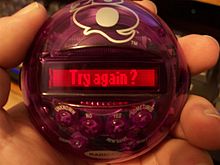- 20Q
-
20Q is a computerized game of twenty questions that began as an experiment in artificial intelligence (AI). It was invented by Robin Burgener.[1]
The game 20Q is based on the spoken parlor game known as twenty questions, and is both a website[2] and a handheld device. 20Q asks the player to think of something and will then try to guess what they are thinking of with twenty yes-or-no questions. If it fails to guess in 20 questions, it will ask an additional 5 questions. If it fails to guess even with 25 questions, the player is declared the winner. Sometimes the first guess of the object can be asked at question 14.
Contents
Principle and history
The 20Q was created in 1988 as an experiment in artificial intelligence (AI) The principle is that the player thinks of something and the 20Q artificial intelligence asks a series of questions before guessing what the player is thinking. This artificial intelligence learns on its own with the information relayed back to the players who interact with it, and is not programmed. The player can answer these questions with: Yes, No, Unknown, Irrelevant, Sometimes, Probably or Doubtful. The experiment is based on the classic word game of Twenty Questions, and on the computer game "Animals," popular in the early 1970s, which used a somewhat simpler method to guess an animal.[3]
The 20Q AI uses a true artificial neural network to pick the questions and to guess.[1][4] After the player has answered the twenty questions posed (sometimes fewer), 20Q makes a guess. If it is incorrect, it asks more questions, then guesses again. It makes guesses based on what it has learned; it is not programmed with information or what the inventor thinks. Answers to any question are based on players’ interpretations of the questions asked. Newer editions were made for different categories, for example music 20Q which has the player think of a song, and Harry Potter 20Q, which has the player think of something from the world of the Harry Potter series.
The 20Q AI can draw its own conclusions on how to interpret the information. It can be described as more of a folk taxonomy than a taxonomy. Its knowledge develops with every game played. In this regard, the online version of the 20Q AI can be inaccurate because it gathers its answers from what people think rather than from what people know. Limitations of taxonomy are often overcome by the AI itself because it can learn and adapt. For example, if the player was thinking of a "Horse" and answered "No" to the question "Is it an animal?," the AI will, nevertheless, guess correctly, despite being told that a horse is not an animal.
Patent applications in the US and Europe were submitted in 2005.[5]Modularity of the artificial intelligence
The modular capability of the 20Q artificial intelligence means that it can be embedded in small screen devices. Currently, there is a handheld version of the AI. The device contains a small portion of the original 20Q website knowledge base; unlike the online versions of the game, the handheld version does not have the ability to learn.
The 20Q artificial intelligence is different from less flexible, and extremely large, expert systems. Its modularity, adaptability, and scalability means that it can be applied to other, more complex devices, for more complex uses.
Game show
Main article: 20Q (game show)On June 13, 2009, GSN(now Nickelodeon) began a TV version of the game, hosted by Cat Deeley of So You Think You Can Dance fame, with Hal Sparks as the voice of the computer.
References
- ^ a b Goddard Engineering Colloquium Announcement
- ^ Official 20Q Website
- ^ with information from: LiCalzi O'Connell, Pamela. "Vegetables And Minerals On The Radar" The New York Times. March 27, 2003; Burgener, Robin, computer architect, inventor.
- ^ Official 20Q Q&A
- ^ US application 102,105 [1] and EP 1710735
External links
Categories:- Artificial intelligence
- Guessing games
- 1988 introductions
Wikimedia Foundation. 2010.

